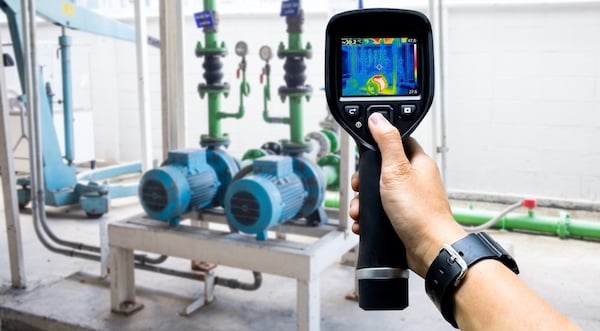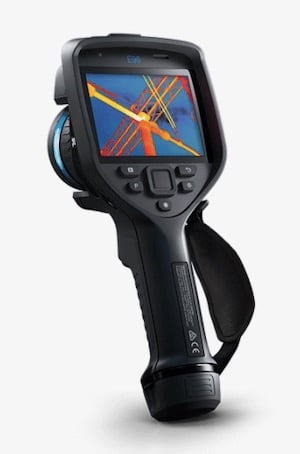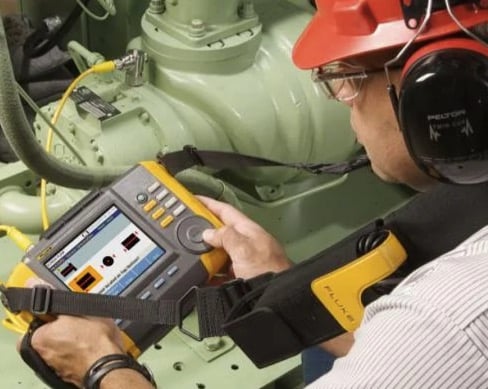This article explores what tools can be used to predict and prevent costly mechanical breakdown events occurring from heat, vibration, or humidity.
Mechanical failure in a machine can lead to lengthy and expensive downtime. Although the problems may be easy to spot when they occur, the replacement of failed components can take a longer time as compared to a broken sensor or wire in the control system. If the frame of the machine breaks, it may lead to extensive repair or complete replacement. What kinds of tools may be used to predict and prevent costly mechanical breakdown events?

Figure 1. There are a variety of tools for monitoring and preventing mechanical failure, such as handheld infrared cameras.
Main Categories of Mechanical Failure Sources
As we have discussed in prior articles, there are three main categories of mechanical failure sources. They may present themselves with various symptoms and can affect different components. Regardless of how these failures appear, a few simple measurements can be employed to help predict — and hopefully prevent — costly downtime from failures.
Those three main sources are heat, vibration, and humidity. These three or a combination of them are usually responsible for failed motors and bearings, mechanical fractures, and most other typical failures. They cannot be avoided entirely, but a well-designed machine should try to minimize the effects. Some common examples include friction-reducing bushings or greased bearings, properly sized wires and airflow for motors, and humidity reduction through temperature control.
Measuring these factors is less straightforward than electrical measurements. In electrical cases, specific quantities should be expected from every reading: voltage from a supply, resistance, and current through devices. Every reading has a meaning that can be related to the operation of the circuits.
In mechanical measurements, there is no specific value for readings which should be expected. There is no exact temperature to be expected in every bearing or a particular value of vibration in a steel frame that should be measured.
Instead, mechanical measurements rely on the long-term recording, or logging, of values. If a brand-new piece of equipment exhibits certain characteristics, any changes in those values can point to potential problems. Logging frequency is often up to the situation, perhaps an hourly, daily, or even monthly recording is sufficient. If a change in any value is detected, it can be assessed whether it’s a one-time anomaly, or if it points to a component beginning the process of breakdown.
Heat Measurement
An effective low-cost measurement tool for thermal analysis is a non-contact infrared (IR) thermometer. They are often called ‘point-and-shoot’ since they use a trigger and often a red laser indicator as well. The level of accuracy depends on the consistency of the measurement, including the ambient air conditions and the distance between the thermometer and the test component. They can often be trusted to within a few degrees, so they can point to large changes, but not if the temperatures only change by fractions of degrees. These thermometers are excellent for quick general data recordings of many points.
Thermal imaging cameras (TICs) can provide an image of a scene, much like a standard camera, but instead they point out hot points and components. It can be used in the same way that the smaller non-contact models are used, except they provide far more specific information. Rather than simply indicating that a metal bearing housing is getting a little warmer than normal, you may be able to see that the top-left side of the bearing housing (for example) is the origin of the heat from friction.

Figure 2. The FLIR E96 14 hand-held infrared camera.
A third type of sensor is perhaps a bit more traditional. Permanently mounted sensors, such as thermocouples or thermistors can be attached to potential problem spots. That way, data recording can happen at any time, and it doesn’t require walking around to measure and record each point. These kinds of sensors are used all the time for process control, but they can work equally as well for predicting failures.
Vibration
There are two similar approaches to measuring vibration: temporary and permanent sensor methods. Vibration information is usually collected through the use of an accelerometer. This is a small circuit that measures accelerations (changes in velocity). Back and forth motion is both cyclic and it obviously shows extreme changes in velocity. Both properties are evaluated to give both an acceleration value as well as an actual motion in mm or inches.
Commercially available mobile vibration sensors can be pressed up against rigid, fixed components to measure vibration in three axes. Again, the actual amount of vibration or motion is not as useful as knowing the deviation from a properly working tool.

Figure 3. A technician uses the Fluke 810 Vibration Tester.
Another modern approach to vibration sensing is to use Smart Phone apps that use the built-in accelerometer to gain information. Since these phones are so common, this can be an excellent cost-saving approach to data collection.
As with temperature, there are also sensors that can be attached to the metal components on a more permanent basis and data is collected remotely.
Again, the logging of data over a period of time is critical to evaluating working conditions, and to predict when failure is likely to occur. The original source of the problem can be evaluated and repaired before the machine fails at the worst possible moment.
Humidity
This final measurement requires specific humidity sensors to properly collect data. They usually are not very expensive or difficult to install. Humidity is different than the previous two measurements since there usually is a stated acceptable humidity range for any device. If the reading falls outside of this boundary (usually the problem is when humidity is too high), an external contact can enable a heater or air dryer to reach the proper conditions.

Figure 4. The Fluke 971 temperature humidity meter tracks temperature and humidity in the air.
An example may be a light bulb inside a control cabinet. It can dry the air if the humidity rises too high, but it should not run constantly because of the heat that is constantly generated, and the energy being wasted if not needed.
In larger systems, such as an entire building’s air system, this sensor may feed information to a central control system that can adjust the HVAC system to reach the proper conditions. The environment should ideally be both low enough to be safe for equipment and high enough to be comfortable for people working in that space.
Copyright Statement: The content of this website is intended for personal learning purposes only. If it infringes upon your copyright, please contact us for removal. Email: admin@eleok.com
